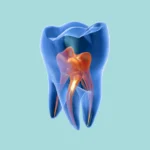“Doctor, please help me! I was playing football, got hit, and my front tooth broke!” This is a phrase we hear incredibly often in the clinic, especially from children and young adults. Unexpected impacts, or even biting down on something a little too hard, can lead to a very common issue: coronal fractures, or crown fractures.
As common as this problem is, its diagnosis and management demand precision to preserve the tooth and prevent any potential complications.
What Exactly Are Coronal Fractures?
Put very simply, doctor, a coronal fracture is a break that occurs in the upper part of the tooth – which we call the crown. This type of fracture can happen due to direct trauma or might be the result of extensive caries that has significantly weakened the tooth’s structure, making it fragile.
What Do They Look Like on X-rays? (Radiographic Features)
When you examine an X-ray, you’ll typically identify a fracture by these specific indicators:
Location
While a fracture can technically occur in any tooth, it’s much more common in single-cusped teeth. We also see it far more frequently in maxillary incisors than in mandibular incisors, primarily because they are more exposed to trauma.
Edge
You’ll observe a sharp, very well-defined line at the point where a portion of the crown is missing.
Shape
The external contour of the crown will appear altered, meaning it won’t look natural like the surrounding teeth.
Internal Structure
The fractured area will show up on the X-ray as a radiolucent area. This is simply because that part of the tooth structure is no longer present.
Number
A fracture might affect a single tooth, or you could potentially find that multiple teeth have been impacted in the same incident.
Classification and Types of Coronal Fractures
We generally categorize fractures based on their depth and the layers of the tooth they involve:
-
Enamel fracture: Here, the break is confined strictly to the enamel layer.
-
Enamel-dentin fracture: This type of fracture has penetrated the enamel and reached the dentin layer.
-
Enamel-dentin-pulp fracture: This is the deepest kind, where the fracture has extended all the way to the pulp (nerve).
Additionally, the direction of the fracture can be horizontal, oblique, or vertical.
Why Do These Matter Clinically? (Clinical Significance)
Coronal fractures aren’t just an aesthetic concern; they carry other significant clinical implications:
-
Naturally, they can cause pain and sensitivity, and undeniably impact a patient’s aesthetic concerns.
-
The greater risk with deeper fractures is the potential for pulp exposure.
-
This particular situation necessitates immediate intervention to prevent further damage or the onset of infection.
-
Treatment largely depends on the fracture’s depth. It can range from something as straightforward as cosmetic bonding to more complex procedures like root canal therapy if the pulp has been exposed.
A Crucial Point in Diagnosis
Remember, doctor, X-rays aren’t always able to reveal very small fractures confined solely to the enamel layer. Therefore, a thorough clinical examination and taking a detailed patient history are considered fundamental for an accurate diagnosis. It’s also really important to conduct follow-up radiographs after a period to confirm pulp vitality and ensure that no complications have developed over time.




















